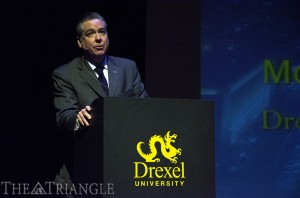Drexel President John A. Fry hosted a town hall May 13 for professional staff of the University, where he gave an update on the strategic plan for Drexel through 2017. He discussed the six strategic priorities for the University as well as the transformational themes from the 30-year master plan.
The two overarching goals of the administration are to redefine Drexel’s physical presence in University City and its interaction with the surrounding areas, and to enhance the overall student experience through better retention efforts, an expanded co-op program and a lower student financial burden.
The strategic plan is less than a year old at this point but is already being implemented across the University. The medical school is in the process of being integrated with the rest of Drexel, removing the legal firewall between the institutions. Each college has also been tasked with creating its own strategic plan, a process that is well underway.
“We’re moving at a very accelerated pace, but we’re all adjusting to it,” Teisa Brown, a staff member of the College of Engineering, said. “The whole process is moving very fast, but it’s not reckless.”
The most visible part of the strategic plan involves the physical building out of the campus and shifting the new growth east toward 30th Street Station instead of north into residential neighborhoods. The expansion of the University has had a profound impact on the neighborhoods north and west of the University, to the point where only 16 percent of houses in Powelton Village are owner-occupied.
By shifting the new developments to the area around 30th Street, along with community outreach through the Dornsife Center, the University hopes to re-establish real neighborhoods and move away from having students overtake residential areas. This involves new University-sponsored housing at Chestnut Square and Lancaster Avenue, as well as development programs like mortgage support for employees and investing in the local K-12 schools.
The University has also started pouring resources into improving its student retention rate, which currently sits well below Drexel’s peer group of universities.
Drexel hired Huron, a management consulting company, to perform a complete evaluation of the University.
“The No. 1 challenge, far and away, that was identified by Huron is improving retention and graduation rates,” Fry said. “This is critical to our competitiveness in the future and is critical also to our students’ impressions of us because we do lag significantly behind our peers in both the yield rate of accepted students who enroll and the persistence and graduation rate of our students.”
Drexel is starting a pilot program with 60 freshmen in the fall to try to address some of the retention issues facing the school. It will be a learning community with better advising, peer tutoring and much more faculty interaction. Drexel’s retention rate lags behind competitors by 12 points, according to Fry. If the program is successful, it will be expanded to include more freshmen in upcoming years.
“The philosophy needs to be ‘recruit to retain’ as opposed to ‘recruit to enroll.’ We’re really interested in bringing in students who are a better fit with our institution and keeping them here for their four or five years so they graduate. And our retention rates need to have an eight in front of them instead of a six,” Fry said.
Along with these retention measures, the administration is focusing on making Drexel more affordable to students. Drexel is consistently ranked among the most expensive colleges in the nation, which threatens the enrollment targets of the strategic plan.
“I think you’ll see Drexel gradually dialing down the percentage increase in tuition and room and board. We’re at about 3.9 percent combined, and that’s down from about 4.5 percent last year. We are very sensitive to this, and we’re going to try and think about ways we can constrain that growth over time,” Fry said.
In addition to partnering with community colleges so that students can transfer into Drexel after two years, the University is also planning a round of endowment fundraising to support undergraduate student aid.
More information about the campus strategic plan and the 30-year master plan can be found online at drexel.edu/strategicplan.



